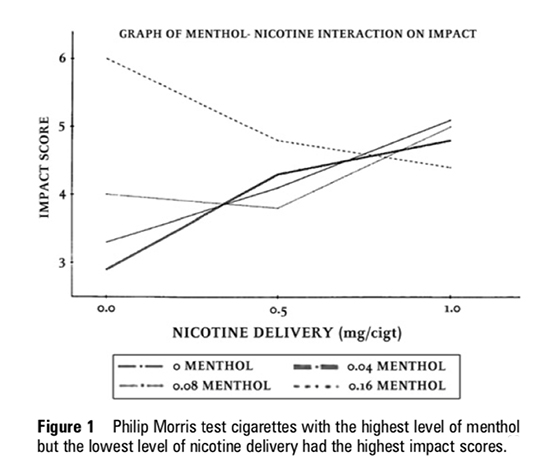“Banning menthol—the last allowable flavor—in cigarettes and banning all flavors in cigars will help save lives, particularly among those disproportionately affected by these deadly products. With these actions, the FDA will help significantly reduce youth initiation, increase the chances of smoking cessation among current smokers, and address health disparities …Together, these actions represent powerful, science-based approaches that will have an extraordinary public health impact.” FDA Statement by Acting FDA Commissioner
Janet Woodcock, MD
Last week the Biden Administration revived a decade-long push to ban the use of menthol in tobacco products. While Big Tobacco shared our goal of transitioning tobacco smokers to less harmful addictions, they pushed back against a ban. “Prohibition does not work,” and “criminalizing menthol will lead to serious unintended consequences,” [1] was the refrain from Altria, maker of Marlboros. Kool, the brand with much more to lose, was more direct.
“rulemaking process will reveal that there is no clear scientific evidence to support a federal menthol and flavour ban.” It vowed to “make sure that the voices of our adult consumers and wholesale and retail partners are represented.” [2]
Let’s make up our own minds.
History
Spuds, the first menthol cigarette, was created in 1925 by Lloyd ‘Spud’ Hughes, who, while suffering from a cold, stored menthol crystals along with his tobacco and discovered the next day that he had created a mentholated cigarette. He sold the cigarettes out of his father’s restaurant in Mingo Junction, Ohio, to railroad and construction workers and ultimately obtained a patent for mentholated cigarettes.
Menthol “flavored” cigarettes represented only about 3% of the market until the ’50s and 60’s when the introduction of filters and a nagging concern raised by the 1964 Surgeon General’s Advisory Committee on Smoking and Health increased market share to around 33%, where it has remained. Interestingly, menthol, which has not been explicitly labeled, is found in about 90% of tobacco products.
In 2009, President Obama signed the Family Smoking Prevention and Tobacco Control Act which allowed the FDA to “ban use of candy, fruit and spice flavors in cigarettes.” Menthol was excluded because of industry concerns, but the FDA was required to prepare a study on menthol.
The twelve-member Tobacco Products Scientific Advisory Committee (TPSAC) issued its report in 2011.
“The committee found that the evidence from toxicologic research, studies of biomarkers in humans, and epidemiologic studies did not support a conclusion that smokers of menthol cigarettes have greater disease risk than smokers of nonmenthol cigarettes. However, we found convincing evidence that menthol cigarettes’ availability increases the number of smokers by increasing the rate of smoking initiation and reducing the rate of cessation, particularly among black Americans.” [3] Emphasis added
Menthol is not simply a flavor
As the TPSAC report indicated, menthol is a naturally occurring product long used for its minty taste and cooling, and anesthetic properties. That cooling effect is a response by two of the nerves in our head, the glossopharyngeal and trigeminal, both involved in biting, chewing, and taste.
 Menthol’s action to decrease the harshness of tobacco smoke increases with larger doses – until the point where the menthol is overwhelming.
Menthol’s action to decrease the harshness of tobacco smoke increases with larger doses – until the point where the menthol is overwhelming.
“menthol, even at subliminal levels too low to be detected by smokers, reduced ‘that nasal sting, tongue bite, and harshness’ of tobacco.” [4]
That graph, to the left, describes the interaction with nicotine. Menthol, in titrated amounts, increases the nicotine delivered without increasing harshness. Nicotine is addictive and menthol “greases the skids.” Any science-based discussion of menthol must recognize that its ability to increase nicotine delivery without any other sensory impact makes it more than just a flavor. The effect at subliminal levels explains why 90% of tobacco products contain some menthol, labeled or not.
Epidemiology
There are any number of studies of the epidemiology specific to mentholated cigarettes. They are a mix of observational studies based on surveys and self-reports. We can argue about how the information was obtained and the various percentages, but the signal is evident despite the noise.
- Blacks smoked far more mentholated cigarettes than Whites – in one study, 5-fold more.
- More adolescents smoke mentholated cigarettes than adults across all ethnic groups. [5]
Long before the term algorithm came to be associated with Internet sales and social media, tobacco companies did it old school, by market research, their term for epidemiology. As a result, by the mid-1970s, marketing was directed at both the Black and youth communities. That is something that Amazon, Facebook, and Google share with Big Tobacco, targeted advertising.
Initiation and Continuation
Again, multiple studies create noise around the details of methodology and statistics, but the signal remains clear. Many individuals begin by smoking mentholated cigarettes.
- “…relative to those who start with non-menthol and remain with non-menthol, youth who start with menthol and remain with menthol have an equivalent level of dependence.” [6]
- There is no difference in the odds of being a daily versus non-daily smoker among those who currently use menthol compared to nonmenthol cigarettes for adults or youths [7]
- “young menthol smokers were interested in quitting, but were less interested in immediate (next 30-day) action than non-menthol smokers.” [8]
Menthol is a gateway, science and Big Tobacco’s marketing and marketing research support that belief.
The Effects of a Menthol Ban
Consider first a model of banning menthol cigarettes, involving three scenarios – switch, quit, never begin. [9]
- You could switch from menthol to non-mentholated – Survey data suggested 36% would switch, 27% in the Black community of menthol smokers.
- You could quit – “39.0% of all menthol smokers and 46.8% of Black menthol smokers reported that they would quit if menthol cigarettes were not available. Although intentions do not always translate into actual behavior…” [Emphasis added]
- Some individuals would never start – based on the belief that mentholated cigarettes are a “starter” cigarette.
They concluded that
“In a scenario in which 30% of menthol smokers quit and 30% of those who would have initiated as menthol smokers do not initiate, by 2050 the relative reduction in smoking prevalence would be 9.7% overall and 24.8% for Blacks; deaths averted would be 633 252 overall and 237 317 for Blacks.”
Of course, in the words of noted epidemiology Yogi Berra, “In theory, there is no difference between theory and practice. In practice, there is.”
Fortunately, we have real-world results from our Northern neighbor, Canada. This study [10] used sales data on tobacco products after some, but not all, Provinces banned the sale of mentholated cigarettes.
- Bans effectively reduced menthol tobacco purchases.
- Hoarding of menthol prior to bans
- No alteration in non-menthol sales
- Significant reduction in youth purchases with substitution of regular cigs
- In adults, less substitution more evasion to tribal sales
- No effect on sales or quitting behavior
“While we find clear evidence that the bans reduced menthol cigarette sales and menthol cigarette use, we also find that the bans are unlikely to be a panacea for reducing youth smoking rates because youths substitute toward non-menthol cigarettes. Moreover, the overall effect on adult smoking is somewhat blunted by evasion of menthol bans toward First Nations reserve purchases.”
Perhaps this is the unintended consequence Big Tobacco mentioned.
An additional study [11] of these smokers may provide a silver lining. They found that more daily menthol smokers tried and succeeded in quitting when compared to their non-menthol brethren.
- 58% tried to quit, compared with 47% of non-menthol smokers
- 21% did quit, versus 11.6% of non-menthol smokers
- 12.7 quit long-term versus 5.2% of non-menthol smokers
- The ban did not affect quitting among occasional menthol or non-menthol smokers
The significant drop between attempting and actually quitting, short or long term, should demonstrate the addictive nature of smoking and give us all pause. It is the strongest argument against beginning.
The Canadian study shows that menthol smokers will look to a grey market, say the Internet or our Indigenous Nations if all sales in the US were banned – or they could switch to e-cigarettes, which is not included in the regulations. At least one study [12], 50% of menthol smokers said they would switch to non-menthol cigarettes, 28% would quit, and 15% would vape. Like whack-a-mole, a menthol ban would not mean an end to smoking. It might well drive these smokers to non-mentholated brands or e-cigarettes – a less harmful but certainly not healthful alternative.
Now that you have the data, what do you, citizen-scientist believe we should do?
[1] FDA to propose ban on menthol-flavored cigarettes, with industry likely to challenge CNBC
[2] US proposes ban on menthol cigarettes popular with black smokers Financial Times
[3] The Threat of Menthol Cigarettes to U.S. Public Health NEJM DOI:10.1056/NEJMp1103610
[4] Menthol’s potential effects on nicotine dependence: a tobacco industry perspective Tobacco Control DOI: 10.1136/tc.2010.041970
[5] Epidemiology of menthol cigarette use Nicotine and Tobacco Research DOI:10.1080/14622203710001649696
[6] Initiation with menthol cigarettes and youth smoking uptake Addiction DOI: 10.1111/j.1360-0443.2012.04045.x
[7] Measures of initiation and progression to increased smoking among current menthol compared to non-menthol cigarette smokers based on data from four U.S. government surveys. Regulatory Toxicology and Pharmacology DOI:10.1016/j.yrtph.2014.08.001
[8] Patterns of Longitudinal Transitions in Menthol Use Among U.S. Young Adult Smokers Nicotine Tobacco Research DOI: 10.1093/ntr/ntu247
[9] Modeling the Future Effects of a Menthol Ban on Smoking Prevalence and Smoking-Attributable Deaths in the United States American Journal of Public Health DOI: 10.2105/AJPH.2011.300179
[10] Intended and unintended effects of banning menthol cigarettes NBER Working Paper 26811
[11] Evaluating the impact of menthol cigarette bans on cessation and smoking behaviours in Canada: longitudinal findings from the Canadian arm of the 2016–2018 ITC Four Country Smoking and Vaping Surveys Tobacco Control DOI: 10.1136/tobaccocontrol-2020-056259
[12] Switching to E-Cigarettes in the Event of a Menthol Cigarette Ban Nicotine and tobacco research DOI: 10.1093/ntr/ntv021




